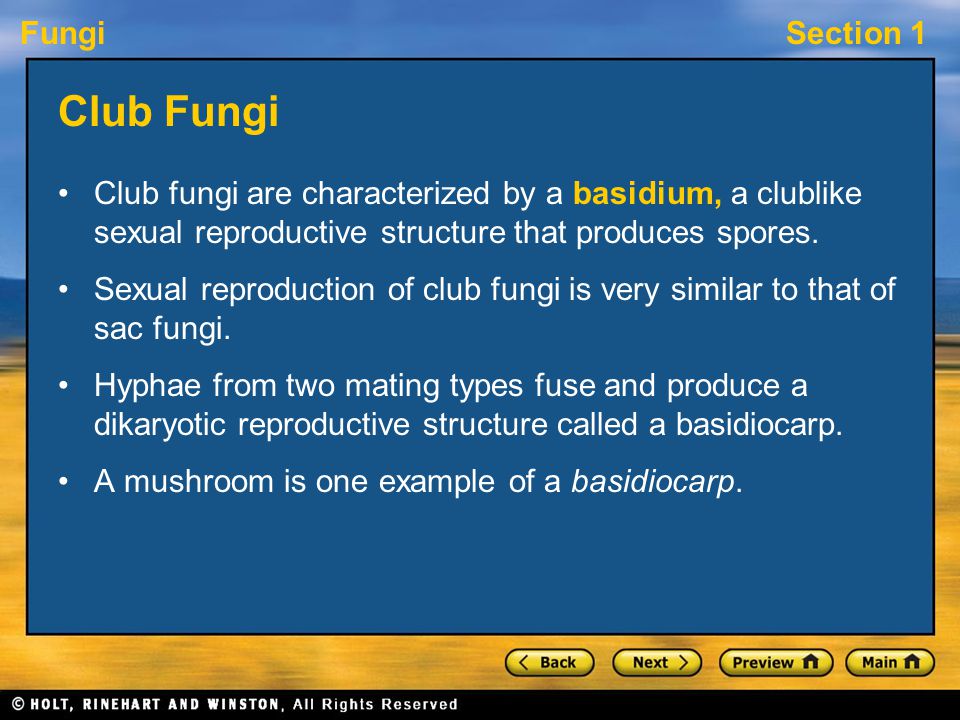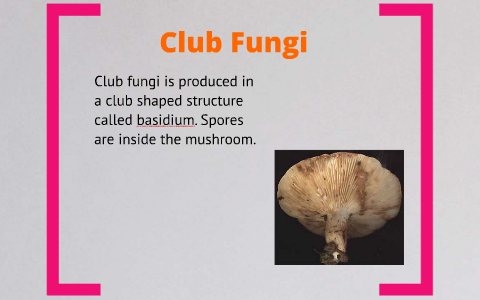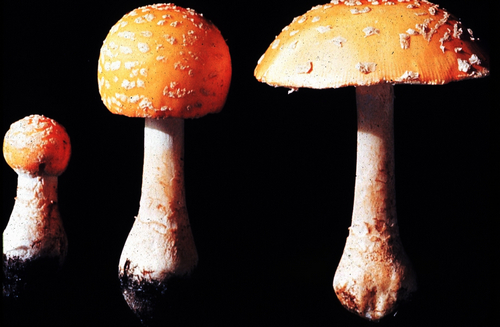Club fungi The common name for members of the class Basidiomycetes Want to thank TFD for its existence?The five true phyla of fungi are the Chytridiomycota (Chytrids), the Zygomycota (conjugated fungi), the Ascomycota (sac fungi), the Basidiomycota (club fungi) and the recently described Phylum Glomeromycota The Deuteromycota is an informal group of unrelated fungi that all share a common character – they use strictly asexual reproductionClub fungi Definition Club fungi is another name given to the group of fungi called Basidiomycetes They are called club fungi because their cells that bear sexual pores, which are called basidia, and they resemble the shape of a small club This diverse group includes fungi such as mushrooms, shelf fungi, coral fungi, jelly fungi, and so on

Club Fungi High Resolution Stock Photography And Images Alamy
Club fungi life cycle
Club fungi life cycle-Club fungus definition is any of various basidiomycetes (family Clavariaceae) with a simple or branched often clubshaped sporophoreTell a friend about us, add a link to this page, or




Clavulina Rugosa Wrinkled Club Fungus
Basidiomycetes are often called club fungi because the cells (basidia) that bear the sexual spores resemble a small club Biologically, basidiomycetes follow the same theme as the rest of the fungal kingdom; The basidia is clubshaped, and basidiomycetes are also called club fungi Examples Agaricus (edible mushrooms), Puccinia (Rust fungi), Ustilago (Smut fungi), Polyporus (Bracket fungi), Candida etc Deuteromycetes (imperfect fungi) There are about 17,000 species of Deuteromycetes They only have asexual or vegetative stagesClub Fungi (basidiomycota) mushroom producing fungi with developing club shaped fruiting bodies called basidia on the gills under its cap This group of fungi, which contains tens of thousands of known species, is distinguished by the club
Phylum basidiomycota and club fungi club fungi composed of septate hyphae, phylum name refers to basidium basidium a clubshaped structure that develops during sexual reproductionDefine club fungi club fungi synonyms, club fungi pronunciation, club fungi translation, English dictionary definition of club fungi Noun 1 Basidiomycetes large class of higher fungi coextensive with subdivision Basidiomycota class Basidiomycetes class a taxonomic group containing The word has New Latin and Greek origins and was first coined in text in the early 1800's, and refers to the threadlike body of a fungus The main part of the fungus is the mycelia, which lives inside the substrate (wood, straw, grain, etc) The mushrooms that we eat are actually just a small visible part of the organism
Club fungi are dikaryotic mycelia (they have cells with two nuclei)Mostly reproduce sexually, rarely asexuallyMost are multicellularHave a clubshaped special hyphae on the underside of their caps How do they acquire nutrients Sac fungi are heterotrophic However, they can be saprophytic, parasitic, or mutualistic, meaning they can haveNoun 1 club fungus a clubshaped coral fungus coral fungus any of numerous fungi of the family Clavariaceae often brightly colored that grow in often intricately branched clusters like coral Based on WordNet 30, Farlex clipart collection © 0312 Princeton University, Farlex Inc Fungi are a group of sporeproducing organisms feeding on organic matter, including moulds, yeasts, mushrooms, and toadstools The Kingdom Fungi (or Mycota) is a group of living organisms that are multicellular, eukaryotic, and heterotrophic in nutrition Fungi live mostly as saprobiotic or often parasites




Club Fungi Greeting Cards Fine Art America



Clubs
Club Fungi, Other Funguslike Organisms back to menuornextor previous see also Lower Club Fungi;Other Funguslike Organisms I Club Fungi A Higher Club Fungi 1 Mycelium 2Explore Richard Hanlin's board "Club fungi" on See more ideas about fungi, stuffed mushrooms, magical mushroomsIt is a morphologically complex tissue and forms structures such as the typically mushroomshaped basidiocarps commonly seen in nature Sexual reproduction of the club fungi begins upon fusion of two primary hyphae to form a clubshaped structure, known as a basidium




Clavulinopsis Luteoalba Apricot Club Fungus




Club Fungi High Resolution Stock Photography And Images Alamy
Basidiomycetes are Commonly known as club fungi and known forms are mushrooms, bracket fungi or puffballs Ascomycetes are Commonly known as sacfungi, the ascomycetes are mostly multicellular, eg, Penicillium, or rarely unicellular, eg, yeast (Saccharomyces) Some examples are Aspergillus, Claviceps, and Neurospora NeurosporaThe fungi in the Phylum Basidiomycota are easily recognizable under a light microscope by their clubshaped fruiting bodies called basidia (singular, basidium), which are the swollen terminal cell of a hypha The basidia, which are the reproductive organs of these fungi, are often contained within the familiar mushroom, commonly seen in fields after rain, on the supermarket shelves,The club fungi is known to contain fifteen thousand species under it It has a reproductive organ names as basidium which allows sexual reproduction as well as asexual reproduction for these kind of fungi Hence, the correct option is D) club fungi Answerd by srprice




Giant Club Fungus Clavariadelphus Pistillaris Baden Wurttemberg Germany Stock Photo Alamy



Club Fungi King Of Kingdoms
Types of Fungi Scientists often divide fungi into four groups club fungi, molds, sac fungi, and imperfect fungi Some of the more common fungi that you are likely to see or use everyday are described below Mushrooms Mushrooms are part of the club fungi group Mushrooms are the fruiting body of a fungusBasidiomycota The Club Fungi The fungi in the Phylum Basidiomycota are easily recognizable under a light microscope by their clubshaped fruiting bodies called basidia (singular, basidium), which are the swollen terminal cell of a hyphaThe basidia, which are the reproductive organs of these fungi, are often contained within the familiar mushroom, commonly seen in fields afterCLUB AND CORAL FUNGI The club and coral fungi provide a catchall for a variety of often only distantly related fungi Clavaria laeticolor, shown at farleft is as simple as such fungi can be but illustrates their essential characteristics The basidioma or fruiting body is a simple cylinder arising from the substrate, soil in this case




The Kingdom Fungi Chapter Ppt Video Online Download




It S Fungus Time Freya S Research
Club fungi (fairy clubs) Those fungi of the families Clavariaceae and Clavulinaceae that form clubshaped fruit bodies Source for information on club fungi A Dictionary of Plant Sciences dictionaryThe Club Fungi Introduction The Basidiomycota contains about 30,000 described species, which is 37% of the described species of true Characteristics Basidiomycota are unicellular or multicellular, sexual or asexual, and terrestrial or aquatic Indeed, Discussion of PhylogeneticClub Fungus May 25 Hey everyone, there is a high energy wrestling themed punk rock band called Kayfabe out of Dalton GA I saw them live and they completely blew me away If you are a fan of punk rock or professional wrestling please check them out and share thier page They are a super fun band Club Fungus was live




White Club Fungi Stock Image B250 13 Science Photo Library




Gardening Club Fungi Galore The Land Rover Owners Ex Wife
Basidiomycota are typically filamentous fungi composed of hyphae Most species reproduce sexually with a clubshaped sporebearing organ ( basidium) that usually produces four sexual spores (basidiospores) Basidia are borne on fruiting bodies (basidiocarps), which are large and conspicuous in all but the yeasts, rusts, and smutsElaborate fruiting body of a dikaryotic mycelium of a club fungus Stipe stalk Pileus Cap of mushroom Gills structure that produces spores Basidium/Basidia Clubshaped, reproductive structure in which club fungi produce sporesClubs and Corals Ascomycota / Basidiomycota by Michael Kuo The mushrooms I have lumped together as "clubs and corals" are related only in their general appearance, and not in any taxonomic or scientific sense In fact some of them are radically different, from a mycological standpoint, belonging to entirely different phyla




Yellow Club Naturespot




Club Fungi Facts Club Mushroom Dk Find Out
The club fungi are believed to be closely related to the sac fungi Both groups have cells which are separated by septa (walls), and both have a dikaryotic phase in their life cycle;The simple, clubshaped or more or less cylindrical holo or homobasidium lacks septa, and has a rounded apex It originates as a terminal cell of a binucleate hypha of the secondary or tertiary mycelium in the basidiocarp (Fig 138) The narrow elongated, binucleate young basidium is separated from the supporting hypha by a septum (a)Club fungi can reproduce asexually, but sexual reproduction is more common They reproduce using spores Development Sac fungi grow hyphae from the spore The mycelia have a huge surface area Examples Some examples of club fungi include mushrooms, polypores, puffballs, boletes, and bird's nest fungi




Club Fungi Stock Photos Royalty Free Images Depositphotos



Club And Coral Fungi
Find the perfect club fungi stock photo Huge collection, amazing choice, 100 million high quality, affordable RF and RM images No need to register, buy now!To this category belong the smut diseases of com, wheat, oats, and barley as well as the wheat rusts They destroy several million rupees worth of crops every year ADVERTISEMENTS Some of the higher Basidiomycetes such as the pore fungi are the common wood rotters They destroy lumbar and timberThey are important decomposers, plant pathogens,




Club Fungi Images Stock Photos Vectors Shutterstock



Fungi Basidiomycota The Club Fungi Sparknotes
A phase with two haploid nuclei per cell The septum of the club fungi is somewhat different from those of sac fungi and is referred to as a dolipore septum Club fungi, Clavariadelphus truncatus, exceedingly rare, endangered, on Red Data List, said to be edibleBa·sid·i·o·my·ce·tes (basid'ēōmīsēt'ez), One of the four major classes of fungi, characterized by a sporebearing organ (basidium), usually a single clavate cell, which bears basidiospores after karyogamy and meiosis The class comprises the smuts, rusts, mushrooms, and puffballs Excluding mycotoxins, there is only one human pathogen, the




Club Fungus Images Stock Photos Vectors Shutterstock




Plant Plants Fungus Fungi Basidiomycetes Club Fungus Club Fungi Gill Fungus Gill Fungi Mushrooms Mottlegill Mottl Stock Photo Alamy
Fungi The division of fungi known as the club fungi, Basidiomycota, includes some of the most familiar fungi Mushrooms, puffballs, and shelf fungi are all members of this group, as are the plant rusts and smuts This group, which contains approximately 15,000 known species, is distinguished by the presence of a club shaped reproductive organClub Fungi Club fungi (Phylum Basidiomycota) are considered the most highly evolved fungi They are an important group with about 16,000 known species The phylum contains several subgroups whose relationships are not entirely clear One subgroup, the "higher" club fungi, includes those that produce large fruiting bodies such as mushrooms What are the characteristics of club fungi?




Tiny White Club Fungi Multiclavula Mucida By Morpheme Jungledragon



Spindle And Club Fungi
Data source info Hibbett, D S et al (07) A Higherlevel Phylogenetic Classification of the Fungi, Mycological Research 111 Data retrieved on 13 April 09Club fungus definition, any basidiomycete fungus belonging to the family Clavariaceae See moreClub Fungi Biology The familiar mushrooms found on pizzas and in the lawn are part of a group of fungi called club fungi, or basidiomycetes The phylum Basidiomycota consists of 16,000 different species of fungi, including the shelf or bracket fungi found on dead trees and the less well known puffballs, bird's nest fungi, and stinkhorns




Freaky Fungi The Wildlife Trusts




Clavariadelphus Pistillaris Giant Club Fungus Identification
Coral fungi is a term that's broadly used to cover a wide range of fungi having erect, clubshaped, or branched bodies Also known as club fungi, worm mold, antler fungi, and spaghetti mushrooms, they look like corals found on the ocean floor and have a clustered appearance




Plant Plants Fungus Fungi Basidiomycetes Club Fungus Club Fungi Gill Fungus Gill Fungi Mushrooms Mottlegill Mottl Stock Photo Alamy




Hillis2e Ch22



1




Funky Club Fungi This Is Club Fungi Of Some Sort Still Wo Flickr




Coral Or Club Fungi I Was Excited To Find This Fallen Log Flickr




Jelly Club Fungi Ascomycetes Stock Photo Picture And Royalty Free Image Image




Hillis2e Ch22




Purple Club Fungi Fungi Bob Armstrong S Photos Naturebob Com




The Vegetable Caterpillar An Intriguing Fungus Karen Retra




Yellow Club Fungus In Forest Trandeiras Galicia



Leotia Lubrica Wikipedia



Ascomycota



Fungi



Scarlet Caterpillar Club Cordyceps Militaris




Ch 22 Fungi Ppt Video Online Download




Yellow Club Fungus Clavulinopsis Helvola Stuffed Mushrooms Fungi Mushroom Fungi




The Basidiomycetes Club Fungi Flowering Plants 78 Steps Health




Coral Fungus Biology Britannica




702 Best Club Fungi Images Stock Photos Vectors Adobe Stock




Yellow Club Fungi Unusual Fungi Growing In The Damp On Ang Colin Mayes Flickr




Club Fungi Images Stock Photos Vectors Shutterstock




File Club Fungi Jpg Wikimedia Commons




Ppt Club Fungi Powerpoint Presentation Free Download Id




Clavarioid Fungi Wikipedia




Club Fungi Stock Photos Royalty Free Images Depositphotos



Club Fungi King Of Kingdoms



Club And Coral Fungi




Clavaria Argillacea Moor Club Fungus




Moor Club Fungus Clavaria Argillacea Growing On Heathland In Surrey Uk Stock Photo Alamy



Basidiomycota




Basidiomycota Phylum Of Fungi Britannica




The Club Fungi Powerpoint




Nature Picture Library Apricot Club Fungus Clavulinopsis Luteoalba Hertfordshire England Uk November Focus Stacked Image Andy Sands




It S The Time Of Year For Fungi As Pictured By Our Camera Club Members South Wales Argus



Whitish Brown Club Fungi In A Suburban Garden Uk Fungi




Giant Club Fungus Clavariadelphus Pistillaris Group Growing Under Beeches Stock Photo Alamy




Club Fungi



Club And Coral Fungi




Nature Picture Library Yellow Club Fungus Clavulinopsis Helvola Growing In Unimproved Grassland Sussex England Uk October Adrian Davies




Clavulina Rugosa Wrinkled Club Fungus




Fungi Protist Prezi By Nini Ho



Yellow Club Fungus Life And Opinions Life And Opinions




Clavariadelphus Truncatus Wikipedia



Club Fungi Project Noah




Club Foot Fungus Naturespot




Basidiomycota The Club Fungi Biology For Majors Ii




Club Fungi




Clavulinopsis Laeticolor Handsome Clubfungus



Purple Club Fungi Fungi Bob Armstrong S Photos Naturebob Com




Club Fungi Images Stock Photos Vectors Shutterstock




Fungi Fungi With Club Shaped Parts That Produce Spores Called Club Fungi Mushroom Fungi Stuffed Mushrooms



Clubs




White Club Fungi Stock Image B250 1322 Science Photo Library



Yellow Club Fungus Life And Opinions Life And Opinions




Club Fungi Observation Uk And Ireland Ispot




702 Best Club Fungi Images Stock Photos Vectors Adobe Stock



Club Fungi Club Fungi




Heterotrophs Fungi Basics No Photosynthesis Release Enzymes To




Clavulinopsis Luteoalba Apricot Club Fungus



Fungi




Single White Club Fungi Observation Uk And Ireland Ispot




Bingley Camera Club Fungi Eruption




248 Club Fungi Photos Free Royalty Free Stock Photos From Dreamstime



Club Fungi




Club Fungi Images Stock Photos Vectors Shutterstock




Fungi Lichens I Characteristics Of Fungi A What



Clubs




Club Fungi Kingdom Fungi Phylum Basidiomycota Fungi Kingdom Fungi Stuffed Mushrooms




Clavariaceae Club Fungi Four Species In The Clavariaceae Flickr



Imperfect




Clavulina Rugosa Wrinkled Club Fungus



Clubs




Club Fungi In Oakwood Aka Clavarioid Fungi Basidiomycota Stock Photo Image Of Basidiomycota Nature




Club Fungus Photograph By Fletcher Baylis




Club Fungi Flashcards Quizlet



Cup



Club And Coral Fungi




Purple Fairy Club By Morpheme Jungledragon




Classification Reproduction Svamp




Coral Or Club Fungi I Was Excited To Find This Fallen Log Flickr




248 Club Fungi Photos Free Royalty Free Stock Photos From Dreamstime




Nature In Stock



0 件のコメント:
コメントを投稿